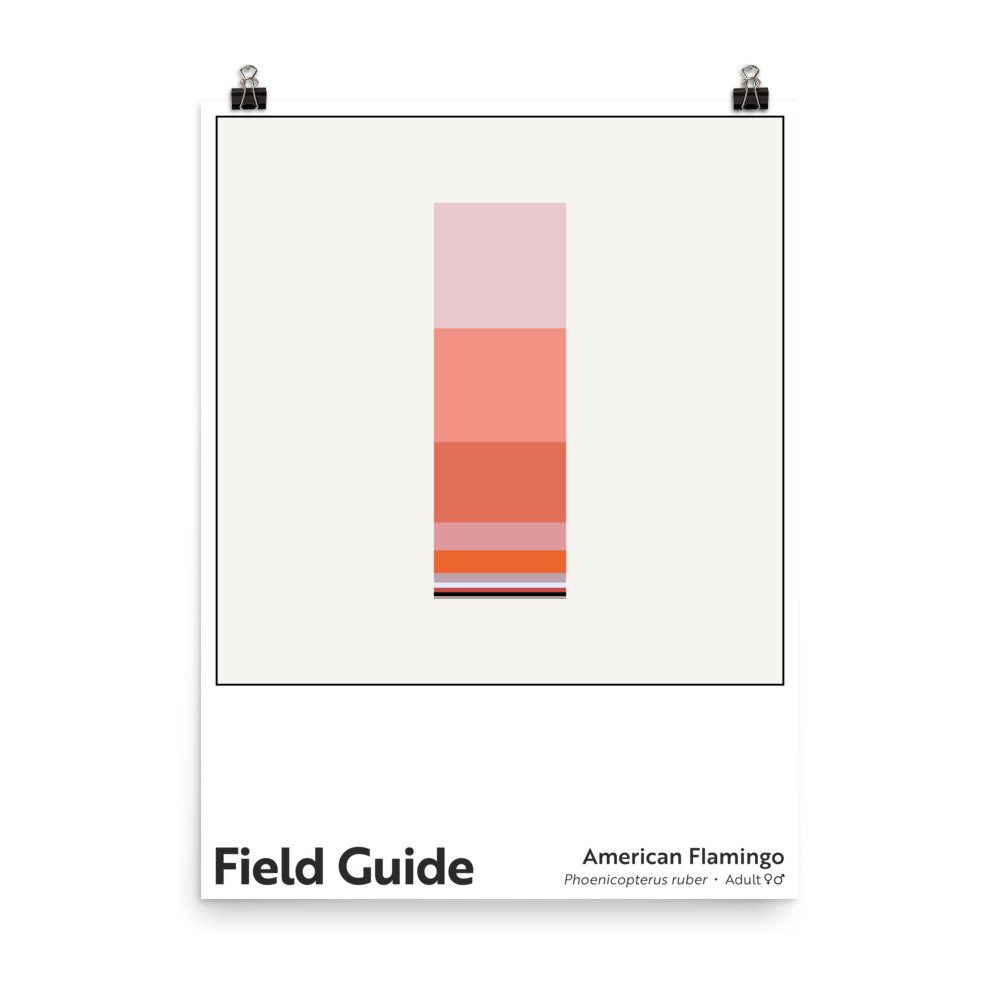 Image 1 of 2
Image 1 of 2

 Image 2 of 2
Image 2 of 2



Field Guide : American Flamingo
Unlimited edition. 18 x 24 inch, museum-quality poster on matte paper.
The flamingo is almost certainly the world’s most famous pink bird. The associations I have with the long-legged wader aren’t your typical bird nerd fare, however. You say “flamingo,” and the Miami Vice theme song starts playing in my head. (Or John Waters and kitschy lawn ornaments spring to mind.) That Miami Vice connection may date me, but I think it’s safe to say that a great many people think of Florida when they think of flamingos. This wouldn’t be especially notable if there were large populations of flamingos in the state, but there aren’t. What gives?
American flamingos are native to the Caribbean, Mexico’s Yucatan peninsula, and parts of South America. There, they frequent mud flats, lagoons, and other wet areas, where they dunk their heads and great, peculiar bills under the surface and strain prey from the water (algae, crustaceans, mollusks, and insects, mostly). They do this dunking with their heads upside down, which explains why the top of the flamingo bill is smaller and weaker than the bottom – they’ve just reversed the standard bill engineering. The algae and brine shrimp the flamingos eat have a lot of beta carotene pigment in them, and the birds metabolize the compound which, in turn, makes their plumage pink to pink-orange, depending on the amount of beta carotene a bird is consuming.
All that pink catches the eye. In 1931, a wealthy Philadelphian who purchased Florida’s Hialeah racetrack decided to import a flock of flamingos from Cuba to occupy the Hialeah grounds. The first flock flew off, returning south, but a second attempt took, and the large, charismatic birds became closely associated with Florida, in no small part thanks to a concerted effort by the state’s tourism industry. So, you might think, as I did as a child, that the bird isn’t native to the US at all, and the Florida association is claptrap. But research has revealed a more complicated history. In fact, there is now plentiful evidence that American flamingos were present in Florida, even breeding there, into the late 19th century. The craze for bird feather-adorned women’s hats in the late 19th and early 20th centuries led to overhunting of target species, including flamingos. Fortunately, some hunter-conservationists of the day noticed that populations of waterbirds were reeling from the combination of habitat loss and the myopic, kill-them-all-for-today’s-pay-day approach of market hunters; they resolved to take action. The reforms they managed to pass represent major victories for the then-nascent conservation movement and, importantly, allowed many waterbird and shorebird populations to recover. The American flamingo, however, did not recover in Florida….or, perhaps, hasn’t yet. The species was only re-designated as “native” to Florida in 2018, and increasingly wild flamingos are visiting the state. Will they come to call it home again? Outside of Florida, the overall American flamingo population has recovered well although habitat destruction and degradation remain concerns.
Note: These archival poster prints feature rich, appealing colors. I encourage customers to take care in handling them until they are framed/protected for display; the darker colors on the matte paper can be scratched. They ship rolled, so customers need to flatten them before framing (or have their framer do so).
Charitable Sales Model: Whenever one of these poster prints is purchased, a charitable contribution equal to 10% of the print’s cost (or $3.60) is made to a nonprofit working to tackle environmental or social challenges. Read more about my charitable sales model here.
Unlimited edition. 18 x 24 inch, museum-quality poster on matte paper.
The flamingo is almost certainly the world’s most famous pink bird. The associations I have with the long-legged wader aren’t your typical bird nerd fare, however. You say “flamingo,” and the Miami Vice theme song starts playing in my head. (Or John Waters and kitschy lawn ornaments spring to mind.) That Miami Vice connection may date me, but I think it’s safe to say that a great many people think of Florida when they think of flamingos. This wouldn’t be especially notable if there were large populations of flamingos in the state, but there aren’t. What gives?
American flamingos are native to the Caribbean, Mexico’s Yucatan peninsula, and parts of South America. There, they frequent mud flats, lagoons, and other wet areas, where they dunk their heads and great, peculiar bills under the surface and strain prey from the water (algae, crustaceans, mollusks, and insects, mostly). They do this dunking with their heads upside down, which explains why the top of the flamingo bill is smaller and weaker than the bottom – they’ve just reversed the standard bill engineering. The algae and brine shrimp the flamingos eat have a lot of beta carotene pigment in them, and the birds metabolize the compound which, in turn, makes their plumage pink to pink-orange, depending on the amount of beta carotene a bird is consuming.
All that pink catches the eye. In 1931, a wealthy Philadelphian who purchased Florida’s Hialeah racetrack decided to import a flock of flamingos from Cuba to occupy the Hialeah grounds. The first flock flew off, returning south, but a second attempt took, and the large, charismatic birds became closely associated with Florida, in no small part thanks to a concerted effort by the state’s tourism industry. So, you might think, as I did as a child, that the bird isn’t native to the US at all, and the Florida association is claptrap. But research has revealed a more complicated history. In fact, there is now plentiful evidence that American flamingos were present in Florida, even breeding there, into the late 19th century. The craze for bird feather-adorned women’s hats in the late 19th and early 20th centuries led to overhunting of target species, including flamingos. Fortunately, some hunter-conservationists of the day noticed that populations of waterbirds were reeling from the combination of habitat loss and the myopic, kill-them-all-for-today’s-pay-day approach of market hunters; they resolved to take action. The reforms they managed to pass represent major victories for the then-nascent conservation movement and, importantly, allowed many waterbird and shorebird populations to recover. The American flamingo, however, did not recover in Florida….or, perhaps, hasn’t yet. The species was only re-designated as “native” to Florida in 2018, and increasingly wild flamingos are visiting the state. Will they come to call it home again? Outside of Florida, the overall American flamingo population has recovered well although habitat destruction and degradation remain concerns.
Note: These archival poster prints feature rich, appealing colors. I encourage customers to take care in handling them until they are framed/protected for display; the darker colors on the matte paper can be scratched. They ship rolled, so customers need to flatten them before framing (or have their framer do so).
Charitable Sales Model: Whenever one of these poster prints is purchased, a charitable contribution equal to 10% of the print’s cost (or $3.60) is made to a nonprofit working to tackle environmental or social challenges. Read more about my charitable sales model here.